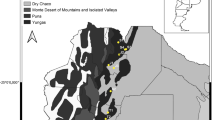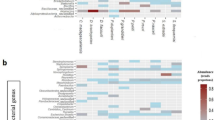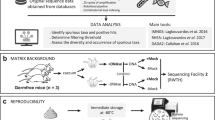Abstract
Fleas serve as arthropod vectors for several emerging and re-emerging infectious disease causing agents including, Rickettsia felis. Although the prevalence of R. felis infection in colonies of fleas has been examined, the influence of the R. felis infection on flea microbiota has not been investigated. We identified three colonies of cat fleas, Ctenocephalides felis, with varying prevalence of R. felis infection (Louisiana State University (LSU), 93.8%; Professional Laboratory and Research Services Inc. (PLRS), 16.4%; Elward II (EL), 0%) and subsequently utilized polymerase chain reaction amplification, restriction fragment length polymorphism analysis and sequencing of the 1.4-kb portions of 16S rRNA genes to examine the diversity of bacteria in the flea populations. A total of 17 different bacterial 16S rRNA gene sequences were identified among the C. felis colonies. The prevalence of two Wolbachia species that were identified in each flea colony differed between colonies and R. felis-uninfected and -infected fleas. Species richness was unchanged among the R. felis-uninfected (LSU, PLRS and EL colonies) and -infected (LSU and PLRS colonies) fleas; however, between R. felis-uninfected and -infected fleas within both the LSU and PLRS colonies, R. felis-uninfected fleas have greater species richness. Diversity indices did not identify a difference in diversity between any of the flea samples. The interaction of endosymbionts within arthropods can widely impact the dissemination of vertically transmitted pathogenic bacteria; and the reciprocal may be true. These results suggest that carriage of R. felis has an impact on the richness of flea microbiota.
Similar content being viewed by others
Log in or create a free account to read this content
Gain free access to this article, as well as selected content from this journal and more on nature.com
or
References
Adams JR, Schmidtmann ET, Azad AF . (1990). Infection of colonized cat fleas, Ctenocephalides felis (Bouche), with a rickettsia-like microorganism. Am J Trop Med Hyg 43: 400–409.
Azad AF, Radulovic S, Higgins JA, Noden BH, Troyer JM . (1997). Flea-borne rickettsioses: ecologic considerations. Emerg Infect Dis 3: 319–327.
Azad AF, Sacci Jr JB, Nelson WM, Dasch GA, Schmidtman ET, Carl M . (1992). Genetic characterization and transovarial transmission of a novel typhus-like Rickettsia found in cat fleas. Proc Natl Acad Sci USA 89: 43–46.
Bandi C, Dunn AM, Hurst GD, Rigaud T . (2001). Inherited microorganisms, sex-specific virulence and reproductive parasitism. Trends Parasitol 17: 88–94.
Boostrom A, Beier MS, Macaluso JA, Macaluso KR, Sprenger D, Hayes J et al. (2002). Geographic association of Rickettsia felis-infected opossums with human murine typhus, Texas. Emerg Infect Dis 8: 549–554.
Bouyer DH, Stenos J, Crocquet-Valdes P, Moron CG, Popov VL, Zavala-Velazquez JE et al. (2001). Rickettsia felis: molecular characterization of a new member of the spotted fever group. Int J Syst Evol Microbiol 51: 339–347.
Case JB, Chomel B, Nicholson W, Foley JE . (2006). Serological survey of vector-borne zoonotic pathogens in pet cats and cats from animal shelters and feral colonies. J Feline Med Surg 8: 111–117.
Chao A . (1984). Nonparametric-estimation of the number of classes in a population. Scand J Stat 11: 265–270.
Ciantar M, Newman HN, Wilson M, Spratt DA . (2005). Molecular identification of Capnocytophaga spp. via 16S rRNA PCR-restriction fragment length polymorphism analysis. J Clin Microbiol 43: 1894–1901.
Colwell RK, Mao CX, Chang J . (2004). Interpolating, extrapolating, and comparing incidence-based species accumulation curves. Ecology 85: 2717–2727.
Gage KL, Schrumpf ME, Karstens RH, Burgdorfer W, Schwan TG . (1994). DNA typing of rickettsiae in naturally infected ticks using a polymerase chain reaction/restriction fragment length polymorphism system. Am J Trop Med Hyg 50: 247–260.
Gorham CH, Fang QQ, Durden LA . (2003). Wolbachia endosymbionts in fleas (Siphonaptera). J Parasitol 89: 283–289.
Goto S, Anbutsu H, Fukatsu T . (2006). Asymmetrical interactions between Wolbachia and Spiroplasma endosymbionts coexisting in the same insect host. Appl Environ Microbiol 72: 4805–4810.
Henderson G, Foil LD . (1993). Efficacy of diflubenzuron in simulated household and yard conditions against the cat flea Ctenocephalides felis (Bouche) (Siphonoptera: Pulicidae). J Med Entomol 30: 619–621.
Henry KM, Jiang J, Rozmajzl PJ, Azad AF, Macaluso KR, Richards AL . (2007). Development of quantitative real-time PCR assays to detect Rickettsia typhi and Rickettsia felis, the causative agents of murine typhus and flea-borne spotted fever. Mol Cell Probes 21: 17–23.
Higgins JA, Radulovic S, Schriefer ME, Azad AF . (1996). Rickettsia felis: a new species of pathogenic rickettsia isolated from cat fleas. J Clin Microbiol 34: 671–674.
Higgins JA, Sacci Jr JB, Schriefer ME, Endris RG, Azad AF . (1994). Molecular identification of rickettsia-like microorganisms associated with colonized cat fleas (Ctenocephalides felis). Insect Mol Biol 3: 27–33.
Kumar S, Tamura K, Nei M . (2004). MEGA3: integrated software for molecular evolutionary genetics analysis and sequence alignment. Brief Bioinform 5: 150–163.
La Scola B, Meconi S, Fenollar F, Rolain JM, Roux V, Raoult D . (2002). Emended description of Rickettsia felis (Bouyer et al., 2001), a temperature-dependent cultured bacterium. Int J Syst Evol Microbiol 52: 2035–2041.
Moreno CX, Moy F, Daniels TJ, Godfrey HP, Cabello FC . (2006). Molecular analysis of microbial communities identified in different developmental stages of Ixodes scapularis ticks from Westchester and Dutchess Counties, New York. Environ Microbiol 8: 761–772.
Murrell A, Dobson SJ, Yang X, Lacey E, Barker SC . (2003). A survey of bacterial diversity in ticks, lice and fleas from Australia. Parasitol Res 89: 326–334.
Noden BH, Radulovic S, Higgins JA, Azad AF . (1998). Molecular identification of Rickettsia typhi and R. felis in co-infected Ctenocephalides felis (Siphonaptera: Pulicidae). J Med Entomol 35: 410–414.
Parola P, Sanogo OY, Lerdthusnee K, Zeaiter Z, Chauvancy G, Gonzalez JP et al. (2003). Identification of Rickettsia spp. and Bartonella spp. in fleas from the Thai-Myanmar border. Ann NYAcad Sci 990: 173–181.
Pidiyar VJ, Jangid K, Patole MS, Shouche YS . (2004). Studies on cultured and uncultured microbiota of wild Culex quinquefasciatus mosquito midgut based on 16S ribosomal RNA gene analysis. Am J Trop Med Hyg 70: 597–603.
Pornwiroon W, Pourciau SS, Foil LD, Macaluso KR . (2006). Rickettsia felis from cat fleas: isolation and culture in a tick-derived cell line. Appl Environ Microbiol 72: 5589–5595.
Ranjard L, Poly F, Nazaret S . (2000). Monitoring complex bacterial communities using culture-independent molecular techniques: application to soil environment. Res Microbiol 151: 167–177.
Regnery RL, Spruill CL, Plikaytis BD . (1991). Genotypic identification of rickettsiae and estimation of intraspecies sequence divergence for portions of two rickettsial genes. J Bacteriol 173: 1576–1589.
Roux V, Fournier P, Raoult D . (1996). Differentiation of spotted fever group rickettsiae by sequencing and analysis of restriction fragment length polymorphism of PCR-amplified DNA of the gene encoding the protein rOmpA. J Clin Microbiol 34: 2058–2065.
Schriefer ME, Sacci Jr JB, Dumler JS, Bullen MG, Azad AF . (1994). Identification of a novel rickettsial infection in a patient diagnosed with murine typhus. J Clin Microbiol 32: 949–954.
Shima K, Terajima J, Sato T, Nishimura K, Tamura K, Watanabe H et al. (2004). Development of a PCR-restriction fragment length polymorphism assay for the epidemiological analysis of Shiga toxin-producing Escherichia coli. J Clin Microbiol 42: 5205–5213.
Stevenson HL, Labruna MB, Montenieri JA, Kosoy MY, Gage KL, Walker DH . (2005). Detection of Rickettsia felis in a New World flea species, Anomiopsyllus nudata (Siphonaptera: Ctenophthalmidae). J Med Entomol 42: 163–167.
Thomas RE, Macaluso KR, Azad AF . (2004). Laboratory rearing and experimental infection of fleas (Siphonaptera). In: Marquardt WC (ed). The Biology of Disease Vectors. Elsevier: New York, NY, pp 727–732.
Wade SE, Georgi JR . (1988). Survival and reproduction of artificially fed cat fleas, Ctenocephalides felis Bouche (Siphonaptera: Pulicidae). J Med Entomol 25: 186–190.
Wedincamp Jr J, Foil LD . (2000). Infection and seroconversion of cats exposed to cat fleas (Ctenocephalides felis Bouche) infected with Rickettsia felis. J Vector Ecol 25: 123–126.
Wedincamp Jr J, Foil LD . (2002). Vertical transmission of Rickettsia felis in the cat flea (Ctenocephalides felis Bouche). J Vector Ecol 27: 96–101.
Wedincamp Jr J, Foil LD . (2003). Rickettsia felis infection in the cat flea (Siphonaptera: Pulicidae). J Entomol Sci 38: 234–239.
Weisburg WG, Barns SM, Pelletier DA, Lane DJ . (1991). 16S ribosomal DNA amplification for phylogenetic study. J Bacteriol 173: 697–703.
Wiggers RJ, Martin MC, Bouyer D . (2005). Rickettsia felis infection rates in an east Texas population. Tex Med 101: 56–58.
Williams SG, Sacci Jr JB, Schriefer ME, Andersen EM, Fujioka KK, Sorvillo FJ et al. (1992). Typhus and typhuslike rickettsiae associated with opossums and their fleas in Los Angeles County, California. J Clin Microbiol 30: 1758–1762.
Zakson-Aiken M, Gregory LM, Shoop WL . (1996). Reproductive strategies of the cat flea (Siphonaptera: Pulicidae): parthenogenesis and autogeny? J Med Entomol 33: 395–397.
Acknowledgements
We thank Andre Zanetti for assistance with statistical analysis. This research was supported by the Louisiana Board of Regents (LEQSF), the National Institutes of Health (P20 RR0201595) and the National Institutes of Allergy and Infectious Disease (AI60821).
Author information
Authors and Affiliations
Corresponding author
Rights and permissions
About this article
Cite this article
Pornwiroon, W., Kearney, M., Husseneder, C. et al. Comparative microbiota of Rickettsia felis-uninfected and -infected colonized cat fleas, Ctenocephalides felis. ISME J 1, 394–402 (2007). https://doi.org/10.1038/ismej.2007.38
Received:
Revised:
Accepted:
Published:
Issue date:
DOI: https://doi.org/10.1038/ismej.2007.38
Keywords
This article is cited by
-
A chromosome-level assembly of the cat flea genome uncovers rampant gene duplication and genome size plasticity
BMC Biology (2020)
-
Arthropod Infection Models for Francisella tularensis
Current Clinical Microbiology Reports (2018)
-
`Candidatus Rickettsia asemboensis’ and Wolbachia spp. in Ctenocephalides felis and Pulex irritans fleas removed from dogs in Ecuador
Parasites & Vectors (2014)
-
Bacterial communities of disease vectors sampled across time, space, and species
The ISME Journal (2010)



